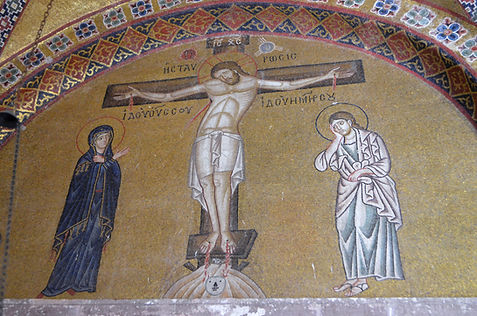The katholikon of the monastery of Hosios Loukas in Phokis is the best preserved smaller centralized churches became common in the period known as the Middle Byzantine era. The late-11th-century monastic church at Daphni, near Athens, is similar to Hosios Loukas in plan, but its mosaics survive in a more fragmentary state. Together, Daphni and Hosios Loukas reflect the classic middle Byzantine program for church decoration.
The monastery lies on the west slope of Mt. Helikon, below the acropolis of ancient Steirion. It is enclosed by a wall and comprises two- and three-storeyed blocks of cells, a bell-tower at the SW corner, the Refectory on the south side and the two adjoining churches, at the centre of the enclosure. The smaller church, dedicated to the Theotokos, was built in the 10th century. It is the earliest known example of the four-column, cross-in-square type, it has a spacious, two-column narthex on the west side and a portico to the west of it. This portico actually connects the two churches. The walls are built in cloisonné masonry and are decorated with rich brick (kufic) ornaments. The diaconicon and the arched portico between the diaconicon and the pulpit were decorated with beautiful wall paintings slightly later in date (11th-12th century) but traces of earlier frescos have also been revealed.
The katholikon is the earliest preserved specimen of the octagonal cross-in-square type of church, built in the first half of the 11th century. Its square nave is surmounted by a dome about 9 meters in diameter that is carried by eight arches resting on massive piers. The domed central space is surrounded by two-storeyed constructions which were modelled as cross-vaulted chapels. Coloured marble panels on the walls and gold mosaics on the curved surfaces mask the structural elements, creating a luminous interior. With the exception of the mosaics of the dome, which collapsed in an earthquake, almost all the original decoration remains intact. Its lavishness may be due to the largesse of Emperor Constantine IX Monomachos (1042 –1055).
The famous fresco of Jesus of Navi, discovered in 1965, dates from the 10th century and actually belonged to the facade of this church but was later covered by marble slabs when the wall became an interior wall of the katholikon. The highest areas (the dome, cupolas, and semi-dome of the apse) represent the celestial sphere. They are reserved for the holiest figures — Christ, angels, and the Virgin — and for heavenly scenes such as the Descent of the Holy Spirit (Pentecost). Scenes from Christ’s life occupy an intermediate zone. Farther down are portraits of saints, with the most important placed in or near the sanctuary; local saints or holy monks appear closer to the entrance of the church, nearest the terrestrial sphere of the worshippers. The program is a microcosm of the Christian universe.
The walls are veneered with marble slabs on the lower section and decorated with superb mosaics on the upper part and the upper floor. The mosaics represent the more severe and abstracted style of the Middle Byzantine decorative art and date from the first half of the 11th century. The Pantocrator and Archangels in the dome belong to a later phase. The mosaic decoration of the walls was completed by contemporary wall paintings in the chapels of the west side. The marble screen was decorated with icons by Michael Damaskenos, dated to the 16th century.
The katholikon is built over a large crypt, shaped as a cross-in-square church, with groin vaults forming the roof. It is dedicated to Aghia Varvara (St. Barbara) and contains three tombs: the one in the north wall is the tomb of Hossios Loucas. The roof and much of the walls are covered with wall paintings, dated to the first half of the 11th century.
The monastery was founded by the hermit Loucas Stereiotis, who lived in the area from 945 A.D. until the day of his death, in 953 A.D. The church of the Theotokos was built while Loucas was alive. He was declared an Hossios of the Orthodox Church and His relics were kept in the church but were later moved to the crypt below the katholicon when this was built.
Page under construction
Sources
Byzantine Architecture by Cyril Mango
Architecture in the Balkans from Diocletian to Süleyman the Magnificent by Slobodan Ćurčić
Oxford Dictionary of Byzantium edited by Alexander Kazhdan
Resources
Hosios Loukas Album (Byzantine Legacy Flickr)
Naos of Hosios Loukas Album (Byzantine Legacy Flickr)
Narthex of Hosios Loukas Album (Byzantine Legacy Flickr)
Hosios Loukas Museum Album (Byzantine Legacy Flickr)
Monastery of Osios Loukas (Religious Greece)












